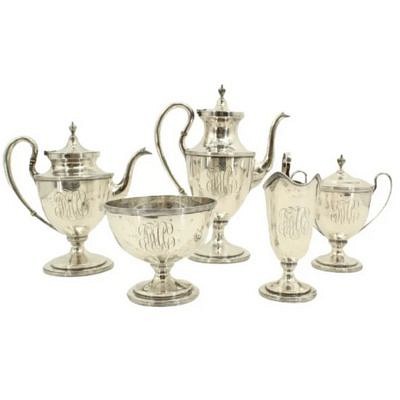Thanksgiving Day Proclamation by George Washington
About Seller
522 South Pineapple Avenue
Sarasota, FL 34236
United States
Sarasota Estate Auction specializes in a wide variety of furniture, antiques, fine art, lighting, sculptures, and collectibles. Andrew Ford, owner and operator of the company, has a passion for finding the best pieces of art and antiques and sharing those finds with the Gulf Coast of Florida.
Two ways to bid:
- Leave a max absentee bid and the platform will bid on your behalf up to your maximum bid during the live auction.
- Bid live during the auction and your bids will be submitted real-time to the auctioneer.
Bid Increments
| Price | Bid Increment |
|---|---|
| $0 | $10 |
| $100 | $25 |
| $250 | $50 |
| $1,000 | $100 |
| $2,500 | $250 |
| $7,500 | $500 |
| $20,000 | $1,000 |
| $50,000 | $2,500 |
| $100,000 | $5,000 |
| $250,000 | $10,000 |
About Auction
Jan 20, 2024
Artists to include: Jorge Blanco, Leonardo Nierman, Picasso, LeRoy Neiman, Darrell Crisp, Francois Krige, Mino Delle Site, Peter Max, Edward Povey, Sky Jones, Robert Rauschenberg, and others. There are also 7 Original Charles Schulz Drawings done by Reuben Timmins, Production Cels, over 200 lots of Important Books and Manuscripts, Sterling Silver, a Jane Kostick Geometric Wooden Sculpture, Modern Design and Furniture, Fantastic Estate Jewelry, and so much more! Sarasota Estate Auction sarasotaestateauction@gmail.com
- Lot Description
Thanksgiving Day Proclamation by George Washington 1795. This document is George Washington’s Thanksgiving Proclamation issued on January 1, 1795; it was his second Thanksgiving Proclamation, it said the country will celebrate a day of Thanksgiving on February 19, 1795, and the proclamation had nothing to do with the Thanksgiving the Pilgrims enjoyed way back in the early 1600’s. This proclamation was issued basically to celebrate the end of the Whiskey Rebellion and to honor the way the rebellion was ended without much bloodshed. The Whiskey Rebellion (also known as the Whiskey Insurrection) was a violent tax protest in the United States which began in 1791 and ended in 1794 during Washington’s presidency. A "whiskey tax" had been imposed in 1791 to generate revenue for the war debt incurred during the Revolutionary War, but it hit farmers and poor people particularly hard, especially in the western region of Pennsylvania, and they protested vigorously against the tax. The first Thanksgiving proclamation was issued by Washington in 1789 to celebrate America’s winning the Revolutionary War against the British, for the country achieving independence, and to offer thanks for establishing a constitutional government. This second Thanksgiving Proclamation had nothing to do with that - it was a way to recognize there were Americans who protested a tax on their livelihood, and at the same time it was handled cautiously by Washington, which prevented all-out war again in this country. The background to the proclamation: many farmers in western Pennsylvania distilled whiskey and profited from its sale and were outraged at the idea of a tax on their own product, and they protested fairly peacefully to begin with, then with open hostility - they resorted to arms - and in Washington’s eyes, America did not need another war to tear the country apart, especially after seven years of war with the British, so in 1794 he dispatched a military force to put down the protest, and it is believed that only five protesters were killed and no American soldiers lost their lives during the three years of conflict. (About fifteen soldiers and militia members died of natural causes or accidents during the three year of protest, but that is a different story.) This averted a major crisis in the country, and the second proclamation was a way to show the rebellion ended - “with liberty and order”, if you read the document - and it was a victory for both freedom and liberty, because the government was able to keep order and the people were able to have their voices and opinions heard. Washington showed restraint in the way he handled the rebellion, and his actions confirmed the supremacy of Federal law in the early days of the country and the right of Congress to levy and collect taxes on a nationwide basis, and a war was averted. The hated tax on whiskey was finally repealed in the early 1800’s, but the Whiskey Rebellion was an important saga in the development of the country. Washington showed that the young federal government had the strength to enforce its laws and the will and ability to suppress violent resistance to its laws when it was called for. People had the right to protest, but not go too far with it, and that is the importance of this rare and unique document. The beginning of the proclamation reads “By authority. By the President of the United States of America, a proclamation. ... to set apart and observe Thursday the nineteenth day of February next, as a day of public thanksgiving ... Done at the city of Philadelphia, the first day of January, one thousand seven hundred and ninety-five”. Philadelphia was the nation’s capital at the time, not Washington, D.C., and it’s ironic that Washington issued this proclamation in the very state where the Whiskey Rebellion began. The document is also considered a broadside, and someone folded it and sent it through the mail to Rev. Joseph Gosse of Sutton, Mass. with remnants of a red candle wax seal on the envelope. Sutton is part of Worcester County in Mass. and the folded letter is dated “Federal Thanksgiving February 19th 1795” at the top left-hand corner. The frame measures 16 1/2 x 13 1/4 in. wide and the proclamation is 14 1/4 x 11 3/4 in. wide, and under glass on both sides. You can see four creases or separations along the horizontal folds of the letter, and a vertical crease or separation along the left edge of the text of the Proclamation, some occasional soiling and a small chip along the left edge of the document and at the top edge on the right side of the document. #251 #7050
- Shipping Info
-
SHIPPING INFORMATION·
Sarasota Estate Auction IS NOT RESPONSIBLE FOR SHIPPING. All shipping will be handled by the winning bidder. Sarasota Estate Auction recommends obtaining shipping quotes before bidding on any items in our auctions. If you are interested in obtaining any information on local shippers, please send us an email and we will kindly send you a list of local shippers. Refunds are not offered under any circumstances base on shipping issues, this is up to the buyer to arrange this beforehand.
Premier Shipping, info@premiershipment.com
BIDDER MUST ARRANGE THEIR OWN SHIPPING. Although SEA will NOT arrange shipping for you, we do recommend our shipper Premier Shipping & Crating at info@premiershipment.com You MUST email them, please do not call. If you'd like to compare shipping quotes or need more options, feel free to contact any local Sarasota shippers. You can email any one of the shippers below as well. Be sure to include the lot(s) you won and address you would like it shipped to. Brennan with The UPS Store #0089 - 941-413-5998 - Store0089@theupsstore.com AK with The UPS Store #2689 - 941-954-4575 - Store2689@theupsstore.com Steve with The UPS Store #4074 - 941-358-7022 - Store4074@theupsstore.com Everett with PakMail - 941-751-2070 - paktara266@gmail.com
-
- Payment & Auction Policies
-
Available payment options
We accept all major credit cards, wire transfers, money orders, checks and PayPal. Please give us a call at (941) 359-8700 or email us at SarasotaEstateAuction@gmail.com to take care of your payments.
-
- Buyer's Premium



 EUR
EUR CAD
CAD AUD
AUD GBP
GBP MXN
MXN HKD
HKD CNY
CNY MYR
MYR SEK
SEK SGD
SGD CHF
CHF THB
THB























